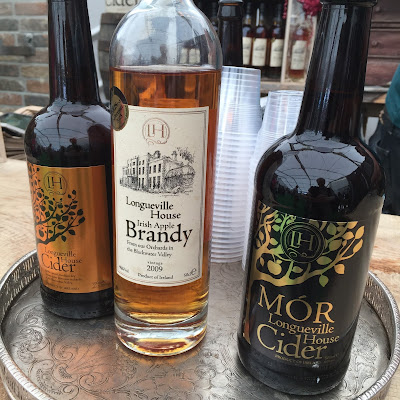There is a clue to the origins of the latest Irish Whiskey Society bottling in the pages of A Glass Apart, the ultimate guide to Irish single pot still whiskey. It's in the description of a legendary single pot still whiskey released at the turn of the millennium, Jameson 15-year old:
... this bottle is dense like a sinking ship full of dates and figs, punctured by the bristle of its own brown sugar gingers and drowning in an oil spillage... Wide cut, unrelentingly lathery, dense Irish spirit aged in an old sherry barrel - the kind of whiskey that would have been right at home in [the Dublin of the late 1800s]The author can't quite bring himself to favour one whiskey above all others but quietly confesses that, if pressed, he would probably name this one.
He's not alone. Many members of the Irish Whiskey Society have tasted old Irish pot still whiskey from long-silent distilleries, enjoyed its characteristic oily, musty heft and now await its return like the Second Coming. Back in 2000, Jameson 15yo indicated both that the new Midleton distillery could venture into the denser reaches of the pot still spectrum, and that there was at least some inclination at the distillery to do so.
Fast forward to today, and Ireland has just marked the centenary of the 1916 Rising. Rather than focusing solely on the headline events of that year, the hugely popular commemorations aimed to recall the lives of ordinary Irish citizens a hundred years ago.
The Irish Whiskey Society's bottling for 2016 meshed well with this theme. The committee, led by the president, Peter White, aimed to recreate a typical Dublin whiskey of 1916. That would be the heavy pot still spirit mentioned above, aged in an indifferent sherry cask (wood management and consistency not being the thing then that it is now) that kept the distillate character to the fore during maturation.
A sub-committee of Peter, Willie Murphy (a noted collector of old Irish whiskey and whiskey lore) and Fionnán O'Connor (the author of A Glass Apart) drew up a more precise liquid brief for submission to Midleton distillery, heavily influenced by the lingering memory of Jameson 15yo.
With the brief in mind, Billy Leighton, Midleton's master blender, drew samples from three casks that the committee tasted one evening in January at Wynn's Hotel.
 |
| Marrowbone Lane Edition Single Pot Still |
The whiskey chosen from those three for the 1916 commemorative bottling is an 11-year old single pot still. It spent the first 7 years in refill bourbon casks and the last 4 years in a first-fill oloroso sherry cask.
Bourbon casks are not exactly faithful to the period but if the point is to avoid a lot of wood influence, a refill bourbon is the best available option today. A first-fill sherry cask, on the other hand, is quite potent and those final 4 years are clearly imprinted on the liquid.
The whiskey is named the Marrowbone Lane Edition, commemorating one of the "Big Four" distilleries operating in Dublin in 1916, William Jameson & Co, of Marrowbone Lane. It was occupied by rebels during the Easter Rising but is almost entirely forgotten today. Hardly a trace remains of the 14-acre distillery.
The Marrowbone Lane Edition was launched last Thursday at Wynn's Hotel. Wynn's is the current venue for Dublin meetings of the Irish Whiskey Society but it has its own strong associations with 1916. Besides hosting the founding meeting of the Irish Volunteers in 1913 with several leaders of the subsequent Rising in attendance, the hotel was completely destroyed during the fighting of 1916.
The building didn't appear to harbour any grudges and the launch was a happy event with society members and representatives of Irish Distillers enjoying a superb and unique whiskey in historic surroundings.
 |
| Fionnán O'Connor, Peter White, Willie Murphy [Photo courtesy of Ove Grunnér] |
Fionnán introduced the Marrowbone Lane Edition noting, by the way, that it did not turn out to be a reproduction of the elusive Jameson 15yo (that quest continues), but that it is still a fitting nod to the hallowed Dublin whiskeys of a century ago.
The whiskey was filled into cask on February 13th, 2005, and bottled on March 9th, 2016, at a cask strength of 54.7% ABV. The 300 bottles in this release are available only to members of the Irish Whiskey Society.
The tasting notes were also written by Fionnán:
Nose
Sherry – but not the sweet, pungent sherry of many modern malts. Musky old sherry distorted into something drier, more leathery, and less immediately inviting by the pot still mustiness and liquorice once sported by the genre hallmarks. Beneath that, a bass clef robustness of earthy distillate-driven oils, cloves, shoe polishy resins and herbal moss all strangely stained by the Oloroso glaze.
Palate
Like an old traditional Dublin pot still with a touch of the pub’s house sherry tipped in... Classic pre 70s too-dry-for-dried-fruit apricot, old polished floorboards, and sherry stained leather like the musty linoleum over a spicy base so thick that even its irrepressible spices feel a little too heavy for spice. Large sip advised for texture.
Finish
Not so much long as mouth filling. Oils, resins, and a slight sherry echo. The finale, like the palate, is all about weight – and that weight is unapologetically cut with the prickles of its own residual oils.








